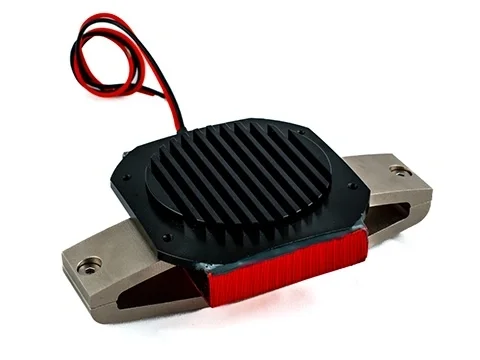The Rise of Advanced Gimbal Systems
From drone-mounted cameras and satellite tracking platforms to laser targeting systems, today’s gimbals are central to modern stabilization and pointing technologies. As these systems grow more advanced, the demand for specialized motion control solutions has increased in parallel. A gimbal’s job is simple in theory but complex in execution: it isolates a payload—such as a camera, sensor, or optical device—from the motion of its base. To achieve this, it must perform precise, rapid adjustments across multiple axes: pitch, yaw, and roll. Powering those axes with both speed and precision is one of the greatest engineering challenges in motion control. For applications requiring extremely fine angular control, typically within ±30 degrees, Rotary Voice Coil Actuators (RVCAs) have become the preferred solution.
Understanding Rotary Voice Coil Actuators
A Rotary Voice Coil Actuator operates on the same fundamental principle as an audio speaker. It consists of two core components:
- A stationary magnet assembly, which creates a constant magnetic field.
- A moving coil assembly, which generates torque when electrical current passes through it.
As current flows through the coil, it interacts with the magnetic field to produce a Lorentz force, causing the coil to move. The motion is smooth, linear, and highly controllable—ideal for precision stabilization systems.
Why RVCAs Excel in Gimbal Applications
RVCAs outperform conventional motor technologies in high-performance gimbals due to three defining characteristics:
1. Zero Backlash and Cogging
Unlike geared motors, RVCAs are direct-drive systems. This eliminates mechanical slop and torque ripple, resulting in exceptionally smooth and precise motion—critical when stabilizing sensitive optical or imaging payloads.
2. High Acceleration and Responsiveness
The coil assembly’s low mass and inertia allow it to change speed or direction almost instantaneously. This makes RVCAs particularly effective at counteracting high-frequency vibrations and maintaining rock-steady tracking.
3. Excellent Controllability
Because the output torque is directly proportional to the input current, control systems can achieve high-resolution adjustments with predictable, linear responses. The result is precise, repeatable performance even in dynamic environments.
The Integration Challenge: Precision Within Constraints
While RVCAs offer clear performance advantages, integrating them into multi-axis gimbals presents unique mechanical and geometric challenges. Each axis—pitch, yaw, and roll—must move independently without interfering with the others. For instance, the actuator driving the pitch motion must leave enough physical clearance for the yaw and roll axes to move freely. Designers often need hollow apertures or custom geometries to allow other components—such as cabling, sensors, or additional actuators—to pass through. This interdependence of movement creates a complex spatial problem that standard off-the-shelf actuators cannot solve efficiently.
The Limits of Commercial Off-The-Shelf (COTS) Actuators
Commercial actuators are built to fixed sizes and specifications. However, modern gimbals are highly optimized systems, where every gram of weight and millimeter of clearance matters. A standard actuator may not:
- Fit within the available physical envelope
- Provide adequate clearance for other moving parts
- Deliver the required torque-to-size ratio for the application
In many cases, engineers are forced to design the gimbal around the actuator—a compromise that limits performance and increases development time.
H2W Technologies: Custom RVCAs for Precision Gimbals
For over two decades, H2W Technologies has specialized in designing and manufacturing custom Rotary Voice Coil Actuators that meet the specific needs of advanced gimbal systems. Rather than offering a one-size-fits-all solution, H2W engages in a collaborative engineering process tailored to each application. The typical process involves:
- Defining Key Parameters: H2W works closely with the customer to identify torque requirements, angular range, payload inertia, available space, and clearance constraints.
- Engineering a Custom Solution: Based on those parameters, H2W designs a bespoke RVCA—from standalone coil and magnet assemblies that drop into existing gimbal structures to fully integrated actuator systems powering all three axes.
- Optimizing for Performance: Each actuator is precisely matched to the gimbal’s geometry and dynamic requirements, ensuring maximum efficiency, stability, and responsiveness.
The result is a motion control solution that complements the gimbal design—rather than constraining it.
Conclusion: Precision Without Compromise
Rotary Voice Coil Actuators represent the future of high-precision motion control in modern gimbal systems. Their smooth, backlash-free motion and linear torque response make them the gold standard for applications that demand accuracy, speed, and stability. By combining custom engineering with decades of experience, H2W Technologies delivers RVCAs that integrate seamlessly into complex, multi-axis gimbals—allowing engineers to achieve the ultimate goal: precision without compromise.

